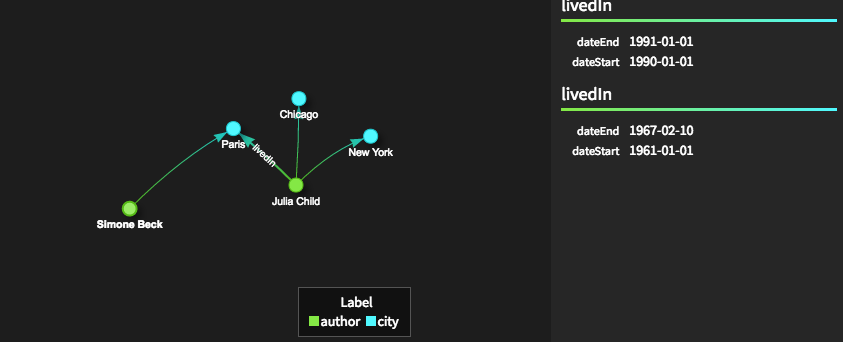Multiple cardinality property or edge
Multiple cardinality allows a property to stored multiple values within a single key, or multiple edges with the same edge label to connect two vertices.
-
Multiple cardinality property
-
Create schema for a multiple cardinality property
item_multand create two vertices, each of which has two items listed for the defined property:schema.propertyKey('item_mult').Text().multiple().ifNotExists().create() schema.vertexLabel('fridgeItem_multiple').properties('item_mult').ifNotExists().create() graph.addVertex(label,'fridgeItem_multiple','name', 'item1','item_mult', ['cheese', 'cheddar cheese']) graph.addVertex(label, 'fridgeItem_multiple','name', 'item2', 'item_mult',['yogurt','Greek yogurt'], 'item_mult', ['key lime yogurt']) g.V().hasLabel('fridgeItem_multiple').valueMap()Because
item_multis defined with multiple cardinality, any number of key value insertions can be made, even using two lists to insert the values. Note that all values are stored in a single list.==>{item_mult=[cheddar cheese, cheese], name=[item1]} ==>{item_mult=[Greek yogurt, key lime yogurt, yogurt], name=[item2]} -
Explore the inserted data further:
g.V().has('fridgeItem_multiple', 'name', 'item2').values('item_mult')==>Greek yogurt ==>key lime yogurt ==>yogurtThis output makes it clear that each entry in the list is a separately stored value.
-
Check for a single list item, specifying a particular value:
g.V().hasLabel('fridgeItem_multiple').has('item_mult', 'Greek yogurt').valueMap()==>{item_mult=[Greek yogurt, key lime yogurt, yogurt], name=[item2]} -
Multiple cardinality edge
-
Create schema for a multiple cardinality edge:
// SCHEMA // PROPERTIES schema.propertyKey('author').Text().single().create() schema.propertyKey('city').Text().single().create() schema.propertyKey('dateStart').Text().single().create() schema.propertyKey('dateEnd').Text().single().create() // VERTEX LABELS schema.vertexLabel('author').properties('author').create() schema.vertexLabel('city').properties('city').create() // EDGE LABELS schema.edgeLabel('livedIn').multiple().connection('author','city').create() schema.edgeLabel('livedIn').properties('dateStart', 'dateEnd').add() // INDEXES schema.vertexLabel('author').index('byAuthor').materialized().by('author').add() schema.vertexLabel('city').index('byCity').materialized().by('city').add() schema.vertexLabel('author').index('byStartDate').outE('livedIn').by('dateStart').add()Note that the edge label
livedInis defined with multi-cardinality. The sample data loaded with graphloader is:author|city|dateStart|dateEnd Julia Child|Paris|1961-01-01|1967-02-10 Julia Child|New York|1970-06-06|1971-09-23 Julia Child|Chicago|1980-04-05|1981-01-01 Julia Child|Paris|1990-01-01|1991-01-01 Simone Beck|Paris|1960-01-01|1962-09-23This data includes two different periods of time in which Julia Child lived in Paris (fictiously), and edges will be multiple because of the multi-cardinality.
With this data loaded, the resulting graph shows the multi-cardinal edges exist:

multiCard1
